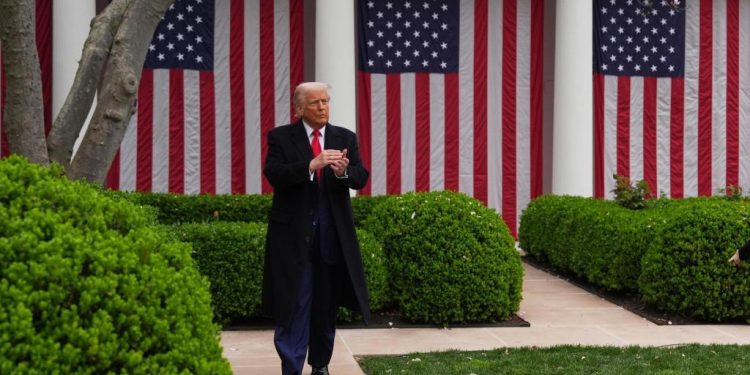By Will Weissert
Washington (AP) – President Donald Trump has promised prices that would increase American import taxes that are high enough to reflect what others assess commercial sanctions on American products.
What he really imposes is based on much more complicated mathematics.
Here is an overview of how the White House obtained its figures:
Why do new rate rates often differ depending on the country?
The Trump administration declared an “economic emergency” to bypass the congress and impose a tariff of 10% on almost all countries and territories. He made even higher samples for around 60 nations which, according to them, are the “worst” delinquents.
The world rates of 10% come into force at 12:01 p.m. on Saturday. The higher rates set for specific countries should go on a minute after midnight on April 9.
Among the so-called worse offenders, there is China, which Trump maintains protecting his producers through “malicious” business practices in addition to prices. These efforts include actions such as the taxation of value added to all goods, the spill of products overproduced on the markets to artificially deflate prices or the manipulation of money.
To determine how higher these rates of these nations should be higher, the White House says that it has calculated the size of the commercial imbalance of each country on goods with the United States and divided by the amount of importation of America.
He then took half of this percentage and made it the new rate rate.
Why not just charge reciprocal rates?
The White House says that its calculations have prevented new prices from going even higher for many countries and demonstrating that Trump is “nice” for global business partners.
Administration maintains that the creation of a reference levy with few exemptions is necessary to prevent China and others from folding new prices by manufacturing goods, then sending them to Vietnam, Cambodia, Mexico or elsewhere to be sent to the United States
This is why the list of price places in the White House includes obscure places such as the Heard and McDonald Islands, which are ininhabit. They are 2,550 miles (4,100 kilometers) from the continent coast in Australia, which claims them as a territory.
Is each country affected?
No. Canada and Mexico are excluded because they are already faced with 25% of taxes on most imported goods that Trump announced last month, in order to force both fentanyl smuggling in the United States
The White House initially declared that all the others would be affected by at least the price of 10%. But administration officials said Thursday that countries already subject to rigorous American sanctions – for example, Russia because of its invasion of Ukraine, as well as Iran, North Korea, Cuba, Belarus and Venezuela – will not face the new world basic price at 10%.
The manager said that was due to the fact that the sanctions and other existing obstacles mean that the United States has so little trade with the places where deficits are minimal.
Why is Trump doing this?
The president spent months to emphasize that America was at his richest at the end of the golden age in the late 1800s and the early 1900s, when he imposed high prices as a key to generating income for the federal government.
Trump even suggested on Wednesday that the United States walking away from higher prices and a federal income tax in 1913 helped to trigger the great depression of the 1930s – an assertion that economists and historians reject to travel.
A more contemporary explanation could be found in the 2025 project, a complete plan compiled by leading conservatives on how to shrink the federal workforce and push Washington further to the right. This explained how Trump could impose high prices worldwide, giving his administration more space to negotiate lower samples with business partners in exchange for American priorities.
White House officials insist that new prices consist more of concluding trade deficits, stimulating the manufacture of the United States and generating government income than negotiating new commercial transactions.
But Trump showed that he was willing to retreat the threats of prices in exchange for concession offers. His administration said that the president was still ready to conclude agreements, a sign that new prices could prove to be more exchanges than permanent policy.
Why do imbalances exchange us?
American trade policy has created an American commercial imbalance worth 1.2 Billion of dollars last year, a gap which, according to some experts, should be committed to ensure the country’s long -term economic force.
But many economists say that the commercial imbalances that Trump seek to correct are based on more than countries that simply use high prices or protectionist business practices to stimulate their own exports. Base the White House pricing mathematics only on trade deficits, for example, does not take into account the demand of American consumers.
The Americans savor the purchase of BMW assembled in Germany, as well as French wine and grains of coffee in Guatemala, and their expenses can fuel commercial imbalances, whatever the tax and pricing policies of countries producing these goods.
This means that any attempt to fill the shortcomings of American exchanges with prices will probably increase the cost of imported goods that Americans buy, which could in turn harm the economy due to increased inflationary pressures.
The editors of the Associated Press Josh Boak and Zeke Miller contributed to this report.
Originally published:
California Daily Newspapers



